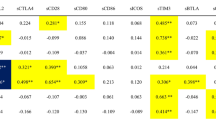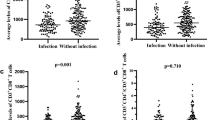Abstract
Type 17 T-helper (Th17) cells have been suggested to be involved in the pathogenesis of antineutrophil cytoplasmic antibody (ANCA)-associated vasculitis (AAV). Th17 cell proliferation is promoted by tumor necrosis factor (TNF)-like ligand 1A (TL1A), which binds to death receptor 3 (DR3) expressed on Th17 cells. Decoy receptor 3 (DcR3) is known to block the TL1A-DR3 pathway by binding TL1A. To evaluate the Th17-TL1A systems as disease activity markers in AAV, we investigated the serum levels of TL1A and DcR3 in AAV patients. Serum IL-17, IL-23, TL1A, and DcR3 were measured by ELISA in 24 AAV patients with microscopic polyangiitis before the initial treatment, 24 AAV patients during remission, and 20 control subjects. There were no significant differences in serum IL-17, IL-23, and TL1A levels among the active-vasculitis patients, inactive-vasculitis patients, and controls. The mean serum DcR3 level was significantly higher in the active-vasculitis patients than in the inactive-vasculitis patients and controls (P < 0.0001, respectively). There were significant positive correlations between the serum DcR3 levels and Birmingham Vasculitis Activity Score (BVAS), myeloperoxidase (MPO)-ANCA titers, white blood cell counts, serum creatinine levels, and serum C-reactive protein levels. In a multiple regression analysis, there was a significant positive correlation between the serum DcR3 level and BVAS (β = 0.650, P = 0.0462). The mean BVAS level was significantly higher in the active-vasculitis patients with high serum DcR3 levels than in those with the low serum DcR3 levels (P = 0.0202). The serum level of DcR3 may be a useful marker for disease activity in AAV.

Similar content being viewed by others
References
Falk RJ, Terrell RS, Charles LA, Jennette JC (1990) Anti-neutrophil cytoplasmic autoantibodies induce neutrophils to degranulate and produce oxygen radicals in vitro. Proc Natl Acad Sci U S A 87:4115–4119
Xiao H, Heeringa P, Hu P, Liu Z, Zhao M, Aratani Y, Maeda N, Falk RJ, Jennette JC (2002) Antineutrophil cytoplasmic autoantibodies specific for myeloperoxidase cause glomerulonephritis and vasculitis in mice. J Clin Invest 110:955–963
Little MA, Smyth CL, Yadav R, Ambrose L, Cook HT, Nourshargh S, Pusey CD (2005) Antineutrophil cytoplasm antibodies directed against myeloperoxidase augment leukocyte-microvascular interactions in vivo. Blood 106:2050–2058
Korn T, Bettelli E, Oukka M, Kuchroo VK (2009) IL-17 and Th17 cells. Annu Rev Immunol 27:485–517
Pappu BP, Borodovsky A, Zheng TS, Yang X, Wu P, Dong X, Weng S, Browning B, Scott ML, Ma L, Su L, Tian Q, Schneider P, Flavell RA, Dong C, Burkly LC (2008) TL1A-DR3 interaction regulates Th17 cell function and Th17-mediated autoimmune disease. J Exp Med 205:1049–1062
Migone TS, Zhang J, Luo X, Zhuang L, Chen C, Hu B, Hong JS, Perry JW, Chen SF, Zhou JX, Cho YH, Ullrich S, Kanakaraj P, Carrell J, Boyd E, Olsen HS, Hu G, Pukac L, Liu D, Ni J, Kim S, Gentz R, Feng P, Moore PA, Ruben SM, Wei P (2002) TL1A is a TNF-like ligand for DR3 and TR6/DcR3 and functions as a T cell costimulator. Immunity 16:479–492
Wen L, Zhuang L, Luo X, Wei P (2003) TL1A-induced NF-kappaB activation and c-IAP2 production prevent DR3-mediated apoptosis in TF-1 cells. J Biol Chem 278:39251–39258
Zhan C, Patskovsky Y, Yan Q, Li Z, Ramagopal U, Cheng H, Brenowitz M, Hui X, Nathenson SG, Almo SC (2011) Decoy strategies: the structure of TL1A:DcR3 complex. Structure 19:162–171
Abdulahad WH, Stegeman CA, Limburg PC, Kallenberg CG (2008) Skewed distribution of Th17 lymphocytes in patients with Wegener’s granulomatosis in remission. Arthritis Rheum 58:2196–2205
Nogueira E, Hamour S, Sawant D, Henderson S, Mansfield N, Chavele KM, Pusey CD, Salama AD (2010) Serum IL-17 and IL-23 levels and autoantigen-specific Th17 cells are elevated in patients with ANCA-associated vasculitis. Nephrol Dial Transplant 25:2209–2217
Fagin U, Csernok E, Müller A, Pitann S, Fazio J, Krause K, Bremer P, Wipfler-Freissmuth E, Moosig F, Gross WL, Lamprecht P (2011) Distinct proteinase 3-induced cytokine patterns in Wegener’s granulomatosis, Churg-Strauss syndrome, and healthy controls. Clin Exp Rheumatol 29:S57–S62
Velden J, Paust HJ, Hoxha E, Turner JE, Steinmetz OM, Wolf G, Jabs WJ, Özcan F, Beige J, Heering PJ, Schröder S, Kneißler U, Disteldorf E, Mittrücker HW, Stahl RA, Helmchen U, Panzer U (2012) Renal IL-17 expression in human ANCA-associated glomerulonephritis. Am J Physiol Renal Physiol 302:F1663–F1673
Ifuku M, Miyake K, Watanebe M, Ito K, Abe Y, Sasatomi Y, Ogahara S, Hisano S, Sato H, Saito T, Nakashima H (2013) Various roles of Th cytokine mRNA expression in different forms of glomerulonephritis. Am J Nephrol 38:115–123
Bamias G, Siakavellas SI, Stamatelopoulos KS, Chryssochoou E, Papamichael C, Sfikakis PP (2008) Circulating levels of TNF-like cytokine 1A (TL1A) and its decoy receptor 3 (DcR3) in rheumatoid arthritis. Clin Immunol 129:249–255
Konsta M, Bamias G, Tektonidou MG, Christopoulos P, Iliopoulos A, Sfikakis PP (2013) Increased levels of soluble TNF-like cytokine 1A in ankylosing spondylitis. Rheumatology 52:448–451
Bamias G, Kaltsa G, Siakavellas SI, Papaxoinis K, Zampeli E, Michopoulos S, Zouboulis-Vafiadis I, Ladas SD (2010) High intestinal and systemic levels of decoy receptor 3 (DcR3) and its ligand TL1A in active ulcerative colitis. Clin Immunol 137:242–249
Aiba Y, Harada K, Komori A, Ito M, Shimoda S, Nakamura H, Nagaoka S, Abiru S, Migita K, Ishibashi H, Nakanuma Y, Nishida N, Kawashima M, Tokunaga K, Yatsuhashi H, Nakamura M (2014) Systemic and local expression levels of TNF-like ligand 1A and its decoy receptor 3 are increased in primary biliary cirrhosis. Liver Int 34:679–688
Bamias G, Evangelou K, Vergou T, Tsimaratou K, Kaltsa G, Antoniou C, Kotsinas A, Kim S, Gorgoulis V, Stratigos AJ, Sfikakis PP (2011) Upregulation and nuclear localization of TNF-like cytokine 1A (TL1A) and its receptors DR3 and DcR3 in psoriatic skin lesions. Exp Dermatol 20:725–731
Watts R, Lane S, Hanslik T, Hauser T, Hellmich B, Koldingsnes W, Mahr A, Segelmark M, Cohen-Tervaert JW, Scott D (2007) Development and validation of a consensus methodology for the classification of the ANCA-associated vasculitides and polyarteritis nodosa for epidemiological studies. Ann Rheum Dis 66:222–227
Lee CS, Hu CY, Tsai HF, Wu CS, Hsieh SL, Liu LC, Hsu PN (2008) Elevated serum decoy receptor 3 with enhanced T cell activation in systemic lupus erythematosus. Clin Exp Immunol 151:383–390
Liu J, Zhao Z, Zou Y, Zhang M, Zhou Y, Li Y, Pang Z, Jin W (2015) The expression of death decoy receptor 3 was increased in the patients with primary Sjögren’s syndrome. Clin Rheumatol 34:879–885
Bayry J (2010) TL1A in the inflammatory network in autoimmune diseases. Nat Rev Rheumatol 6:67–68
Chen J, Zhang L, Kim S (2004) Quantification and detection of DcR3, a decoy receptor in TNFR family. J Immunol Methods 285:63–70
Hung SC, Hsu TW, Lin YP, Tarng DC (2012) Decoy receptor 3, a novel inflammatory marker, and mortality in hemodialysis patients. Clin J Am Soc Nephrol 7(8):1257–1265
Yang CR, Hsieh SL, Ho FM, Lin WW (2005) Decoy receptor 3 increases monocyte adhesion to endothelial cells via NF-kappa B-dependent up-regulation of intercellular adhesionmolecule-1, VCAM-1, and IL-8 expression. J Immunol 174:1647–1656
Pitti RM, Marsters SA, Lawrence DA, Roy M, Kischkel FC, Dowd P, Huang A, Donahue CJ, Sherwood SW, Baldwin DT, Godowski PJ, Wood WI, Gurney AL, Hillan KJ, Cohen RL, Goddard AD, Botstein D, Ashkenazi A (1998) Genomic amplification of a decoy receptor for Fas ligand in lung and colon cancer. Nature 396:699–703
Yu KY, Kwon B, Ni J, Zhai Y, Ebner R, Kwon BS (1999) A newly identified member of tumor necrosis factor receptor superfamily (TR6) suppresses LIGHT-mediated apoptosis. J Biol Chem 274:13733–13736
Zhai Y, Guo R, Hsu TL, Yu GL, Ni J, Kwon BS, Jiang GW, Lu J, Tan J, Ugustus M, Carter K, Rojas L, Zhu F, Lincoln C, Endress G, Xing L, Wang S, Oh KO, Gentz R, Ruben S, Lippman ME, Hsieh SL, Yang D (1998) LIGHT, a novel ligand for lymphotoxin beta receptor and TR2/HVEM induces apoptosis and suppresses in vivo tumor formation via gene transfer. J Clin Invest 102:1142–1151
Harper L, Ren Y, Savill J, Adu D, Savage CO (2000) Antineutrophil cytoplasmic antibodies induce reactive oxygen-dependent dysregulation of primed neutrophil apoptosis and clearance by macrophages. Am J Pathol 157:211–220
Abdgawad M, Pettersson Å, Gunnarsson L, Bengtsson AA, Geborek P, Nilsson L, Segelmark M, Hellmark T (2012) Decreased neutrophil apoptosis in quiescent ANCA-associated systemic vasculitis. PLoS One 7:e32439
Suppiah R, Mukhtyar C, Flossmann O, Alberici F, Baslund B, Batra R, Brown D, Holle J, Hruskova Z, Jayne DR, Judge A, Little MA, Palmisano A, Stegeman C, Tesar V, Vaglio A, Westman K, Luqmani R (2011) A cross-sectional study of the Birmingham Vasculitis Activity Score version 3 in systemic vasculitis. Rheumatology 50:899–905
Acknowledgment
This study was supported in part by a Grant-in-Aid for Progressive Renal Diseases Research, Research on Intractable Disease, from the Ministry of Health, Labour, and Welfare of Japan.
Authors’ contributions
H. Maruyama and K. Hirayama contributed equally to this work.
Author information
Authors and Affiliations
Corresponding author
Ethics declarations
Disclosures
None.
Electronic supplementary material
Below is the link to the electronic supplementary material.
Supplementary Table 1
(PDF 118 kb)
Supplementary Fig. 1
(PDF 67 kb)
Rights and permissions
About this article
Cite this article
Maruyama, H., Hirayama, K., Nagai, M. et al. Serum decoy receptor 3 levels are associated with the disease activity of MPO-ANCA-associated renal vasculitis. Clin Rheumatol 35, 2469–2476 (2016). https://doi.org/10.1007/s10067-016-3321-y
Received:
Revised:
Accepted:
Published:
Issue Date:
DOI: https://doi.org/10.1007/s10067-016-3321-y




